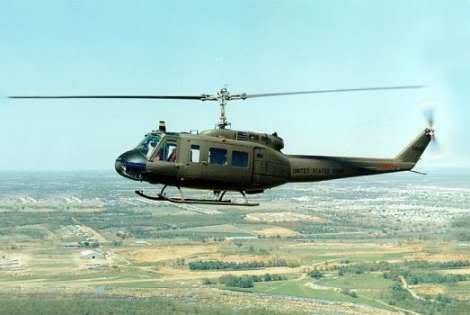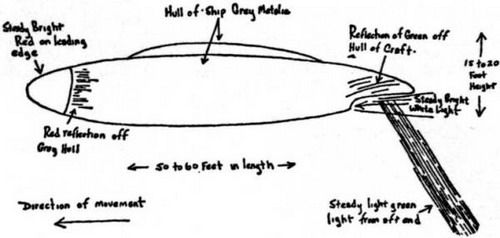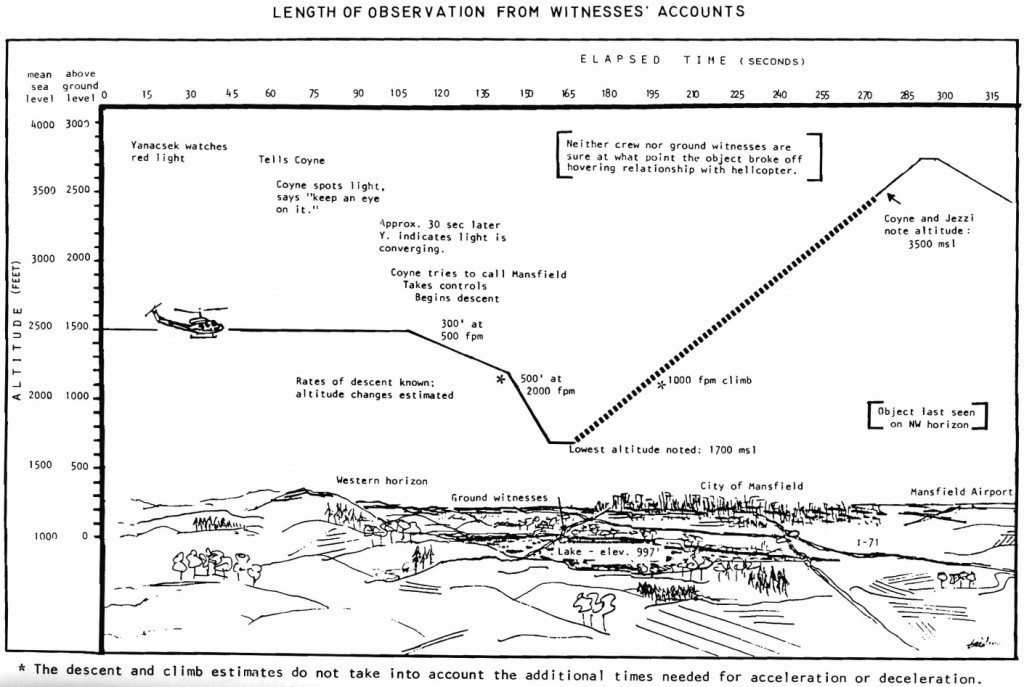Coyne
Helicopter Incident
Date:
October 18, 1973
Location: Mansfield, Ohio, United States
Click
here
for UFOs Are Real (1979) - Pilot Sightings
The
Coyne case (or "Army helicopter incident")
stands out as, perhaps the most credible (in the “high
strangeness” category) of the 1973 wave. An Army
Reserve helicopter crew of four men encountered a gray,
metallic-looking, cigar-shaped object, with unusual lights
and maneuvers, as they were airborne between Columbus
and Cleveland, Ohio.

UH-1
Huey
On
October 18, 1973, at approximately 10:30 PM a UH-1H helicopter
of the United States Army Reserve left Port Columbus,
Ohio, for its home base of Cleveland Hopkins airport,
ninety-six nautical miles to the north-northeast. In command,
in the right-front seat, was Captain Lawrence J. Coyne,
thirty-six, with nineteen years of flying experience.
At the controls, in the left-front seat, sat First Lieutenant
Arrigo Jezzi, twenty-six, a chemical engineer. Behind
Jezzi sat Sergeant John Healey, thirty-five, a Cleveland
policeman who was the flight medic, and Coyne was the
Crew Chief, Sergeant Robert Yanacsek, twenty-three, a
computer technician. The helicopter was cruising at 2,500
feet above sea level at an indicated airspeed of ninety
knots, above mixed hills, woods, and rolling farmland,
averaging 1,200 feet elevation. The night was totally
clear, calm, and starry. The last quarter moon was just
rising.

Coyne
and Jezzi
About
ten miles south of Mansfield, Healey noticed a single
red light off to the west, flying south. It seemed brighter
than a standard aircraft port-wing light, but it was not
considered relevant traffic, and he does not recall mentioning
it. An estimated two minutes later, at approximately 11:02
PM, Yanacsek noted a single red light on the south-east
horizon. He assumed it was either a radio-tower beacon
or an aircraft port-wing light – most likely an aircraft,
since it was not flashing – and he watched it “for
a long time, a minute to ninety seconds” before calling
it to Coyne’s attention. Coyne, smoking, relaxing,
glanced over, noted the light, assumed it was distant
traffic, and told Yanacsek casually to “keep an eye
on it.”
After
an estimated additional thirty seconds, Yanacsek announced
that the light had turned toward the helicopter and appeared
to be on a converging flight path. Coyne verified Yanacsek’s
assessment, grabbed the controls from Jezzi, and put the
UH-1H into a powered descent of approximately 500 feet
per minute. Almost simultaneously, Coyne established radio
contact with Mansfield control tower, ten miles to the
northwest. Coyne thought the flight was an Air National
Guard F-100 from Mansfield. After an initial acknowledgment
(“This is Mansfield Tower, go ahead Army 1-5-triple-4?),
radio contact failed. Jezzi then attempted transmission
on both UHF and VHF frequencies without success. Although
the channel and keying tones were both heard, there was
no response from Mansfield; and a subsequent check by
Coyne revealed that Mansfield had no tape of even the
initial transmission, the last F-100 had landed at 10:47
P.M.

The
red light continued its radial bearing and increased greatly
in intensity. Coyne increased his rate of descent to 2,000
feet per minute and his airspeed to 100 knots. The last
altitude he noted was 1,700 feet. Just as a collision
appeared imminent, the unknown light halted in its westward
course and assumed a hovering relationship above and in
front of the helicopter. “It wasn’t cruising,
it was stopped. For maybe ten to twelve seconds –
just stopped,” Yanacsek reported. Coyne, Healey,
and Yanacsek agree that a cigar-shaped, slightly domed
object substended an angle of nearly the width of the
front windshield. A featureless, gray, metallic-looking
structure was precisely delineated against the background
stars. Yanacsek reported “a suggestion of windows”
along the top dome section. The red light emanated from
the bow, a white light became visible at a slightly indented
stern, and then, from aft/below, a green ‘pyramid
shaped” beam equated to a directional spotlight became
visible. The green beam passed upward over the helicopter
nose, swung up through the windshield, continued upward
and entered the tinted upper window panels.
At
that point (and not before), the cockpit was enveloped
in green light. Jezzi reported only a bright white light,
comparable to the leading light of a small aircraft, visible
through the top “greenhouse’ panels of the windshield.
After the estimated ten seconds of “hovering,”
the object began to accelerate off to the west, now with
only the white “tail” light visible. The white
light maintained its intensity even as its distance appeared
to increase, and finally (according to Coyne and Healey),
it appeared to execute a decisive 45 degree turn to the
right, head out toward Lake Erie, and then “snap
out” over the horizon. Healey reported that he watched
the object moving westward “for a couple of minutes.”
Jezzi said it moved faster than the 250-knot limit for
aircraft below 10,000 feet, but not as fast as the 600-knot
approach speed reported by the others. There was no noise
from the object or turbulence during the encounter, except
for one “bump” as the object moved away to the
west. After the object had broken off its hovering relationship,
Jezzi and Coyne noted that the magnetic compass disk was
rotating approximately four times per minute and that
the altimeter read approximately 3,500 feet; a 1,000 foot-per-minute
climb was in progress. Coyne insists that the collective
was still bottomed from his evasive descent. Since the
collective could not be lowered further, he had no alternative
but to lift it, whatever the results, and after a few
seconds of gingerly maneuvering controls (during which
the helicopter reached nearly 3,800 feet), positive control
was achieved. By that time the white light had already
moved into the Mansfield area. Coyne had been subliminally
aware of the climb; the others not at all, yet they had
all been acutely aware of the g-forces of the dive. The
helicopter was brought back to the flight plan altitude
of 2,500 feet, radio contact was achieved with Canton/Akron,
and the flight proceeded uneventfully to Cleveland.

Apparent
ground witnesses to this event have been found by William
E. Jones and Warren Nicholson, independent UFO researchers
from Columbus, Ohio.
Mrs.
E. C. and four adolescents were driving south from Mansfield
to their rural home on October 18, 1973, at approximately
11 P.M., when they were attracted to a single steady bright
red light. flying south “at medium altitude.”
They watched for perhaps half a minute until it disappeared
to the south over the trees.
Approximately
five minutes later, now driving east on Route 430, approaching
the Charles Mill Reservoir, the family became aware of
two bright lights – red and green – descending
rapidly toward them from the southeast. When first seen,
the angular distance between the lights was about 2 degrees;
the red light appeared to be leading. Mrs. C. pulled over
to the shoulder of the deserted road and kept the engine
and car lights running. The lights – bigger than
point sources – slowed and moved as a unit to the
right of the car and the family became aware of yet another
group of lights – some of these flashing – and
“a beating sound, a lot of racket” approaching
from the southwest. Two of the children (cousins, both
age thirteen) jumped from the car and observed both a
helicopter and the object, which they described as “like
a blimp,” “as big as a school bus,” “sort
of pear shaped.” The object at that point subtended
an angle equivalent to “a 100-mm cigarette box held
at arm’s length.” The object assumed a hovering
position over the helicopter, an estimated 500 feet back
from the road and 500 feet above the trees. (The ground
elevation at the site is almost exactly 1,000 feet above
sea level; thus at the noted 1,700-foot altimeter reading,
the helicopter was actually about 650 feet above the trees.)
The object’s green light then flared up. “It
was like rays coming down,” the witnesses said. The
helicopter, the trees, the road, the car – everything
turned green.” The kids scrambled with fright back
into the car and Mrs. C. proceeded apace. Their estimated
total time outside the car was “about a minute.”
Neither ground witnesses nor aircrew are sure at what
point the two aircraft disengaged; the ground witnesses
reported that the unidentified object crossed to the north
side of the road behind the car, appeared to move eastward
for a few seconds, then reversed its direction and climbed
toward the northwest towards Mansfield – a flight
path which correlates perfectly the motion of the object
established through analysis of the aircrew’s report.
Any
theory of the object’s being a meteor (UFO skeptic
Philip Klass maintains that the object was a “fireball
of the Orionid meteor shower”) can readily be rejected
on the basis of: (1) the duration of the event (an estimated
300 seconds); (2) the marked deceleration and hard-angle
maneuver of the object at closest approach; (3) the precisely
defined shape of the object; and (4) the horizon-to-horizon
flight path.
The
possibility of a high-performance aircraft likewise is
untenable when one examines the positions and colors of
the lights with respect to the flight path of the object.
To have presented the reported configurations, and been
in accordance with FAA regulations, an aircraft would
have had to be flying sideways, either standing on its
tail, tail-to to the helicopter, or upside-down head-on.
Other arguments against aircraft hypothesis are: (1) a
fixed-wing aircraft moving across the line of sight would
appear to move most rapidly when passing directly in front
of the observer; (2) a fixed-wing aircraft would not have
the capability of decelerating from high velocity to “hover”
within a few seconds time; (3) a helicopter would have
the capability of hovering, but would not be capable of
the high forward speeds reported; (4) a conventional aircraft,
if within 500 to 1,000 feet, would have produced noise
audible inside the helicopter; (5) the FAA requires either
a strobe or a rotating beacon on either the top or bottom
of the fuselage, (6) FAA requires that no aircraft shall
fly below 10,000 feet msl at speeds above 250 knots; (7)
some of the features of a conventional aircraft would
have been seen, e.g., wings, engine pods, windows, empennage,
numbers, logo.
Coyne
reported that the Magnaflux/Zygio method of nondestructive
testing was applied to the rotors the following day and
that there was no indication that they had been subjected
to fatigue-producing stresses. Comparable times/distances/directions
support the possibility that the red light first seen
by the C. family, Healey’s red light, and the object
of the encounter were all one and the same. Yanacsek’s
red light on the eastern horizon was under continuous
observation and was unequivocally the object of the encounter.
The
case has maintained its high “strangeness-credibility”
rating after extended investigation and analysis.

Freedom
Of Information Act Document File
Sources:
http://www.clevelandufo.com/?page_id=18
http://www.thelivingmoon.com/49ufo_files/03files2/1973_Lawrence_Coyne_UFO_Helicopter_Case.html
http://www.noufors.com/Coyne_helicopter_incident.html
